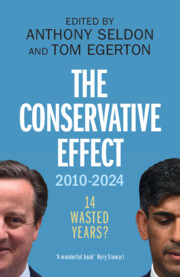Book contents
- Frontmatter
- Contents
- List of Contributors
- Introduction: What Difference Do Governments Make?
- 1 Thirteen Wasted Years (1951–1964)?
- 2 External Shocks
- 3 The Economy
- 4 Foreign and Defence Policy
- 5 Health
- 6 Education
- 7 Environment
- 8 Parting the Unions
- 9 Society and Health Inequalities
- 10 Science
- 11 Culture
- 12 Government, Parliament and the Constitution
- 13 The Conservative Party
- 14 The Realigning Party System
- 15 Elections and Voting
- Conclusion: Fourteen Wasted Years? The Verdict
- Acknowledgements
- Index
12 - Government, Parliament and the Constitution
Published online by Cambridge University Press: aN Invalid Date NaN
- Frontmatter
- Contents
- List of Contributors
- Introduction: What Difference Do Governments Make?
- 1 Thirteen Wasted Years (1951–1964)?
- 2 External Shocks
- 3 The Economy
- 4 Foreign and Defence Policy
- 5 Health
- 6 Education
- 7 Environment
- 8 Parting the Unions
- 9 Society and Health Inequalities
- 10 Science
- 11 Culture
- 12 Government, Parliament and the Constitution
- 13 The Conservative Party
- 14 The Realigning Party System
- 15 Elections and Voting
- Conclusion: Fourteen Wasted Years? The Verdict
- Acknowledgements
- Index
Summary
A sustained period of Conservative government would normally be expected to usher in constitutional stability. But the reverse was largely true for the period 2010-24. During these years constitutional controversies were rarely far from the news, partly thanks to deliberately planned changes, but mostly due to radically shifting conventions and political behaviour. Across the time period, the direction of change was also very far from consistent. The initial coalition years were marked primarily by pressures towards greater constitutional pluralism, though Liberal Democrat reform ambitions were often held back by Cameron’s Conservatives. Later, any prospect of calm under single-party government was soon punctured by the pressures of Brexit. This eventually brought into question almost every aspect of the UK’s constitutional arrangements, and inflicted painful splits within the Conservative Party over questions of governance. In particular, Boris Johnson’s populist approach was characterised by wholesale disregard for constitutional norms, and highlighted vulnerabilities in the UK’s key democratic arrangements which few would previously have anticipated. If one commonality can be discerned across this fourteen-year period of constitutional extremes, it is the largely unconservative nature of policy.
Keywords
- Type
- Chapter
- Information
- The Conservative Effect, 2010–202414 Wasted Years?, pp. 376 - 411Publisher: Cambridge University PressPrint publication year: 2024



